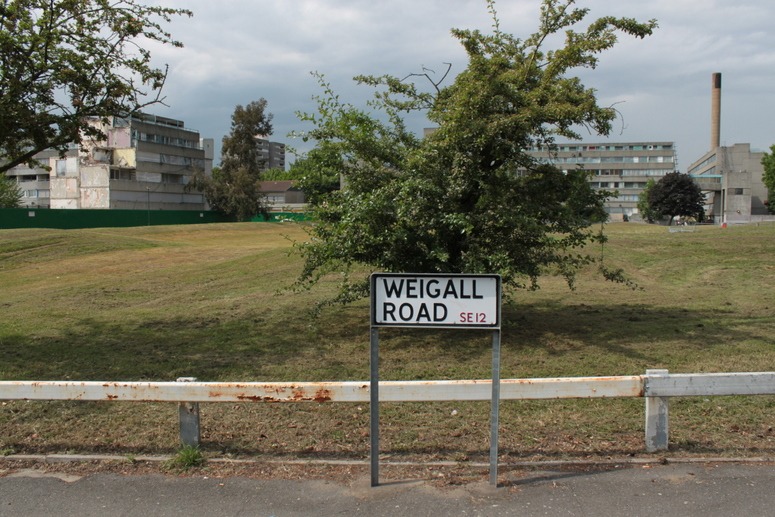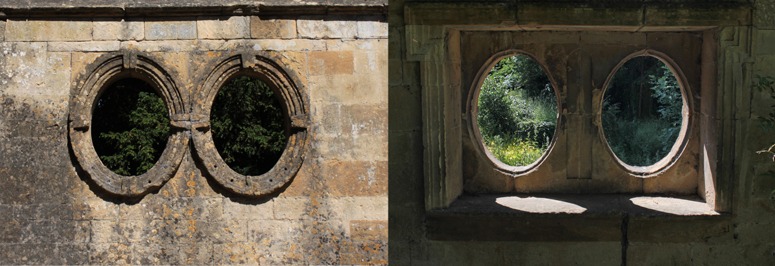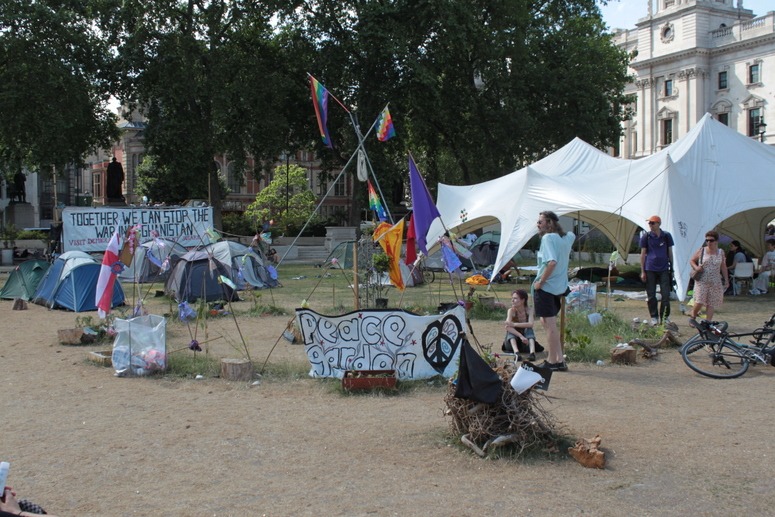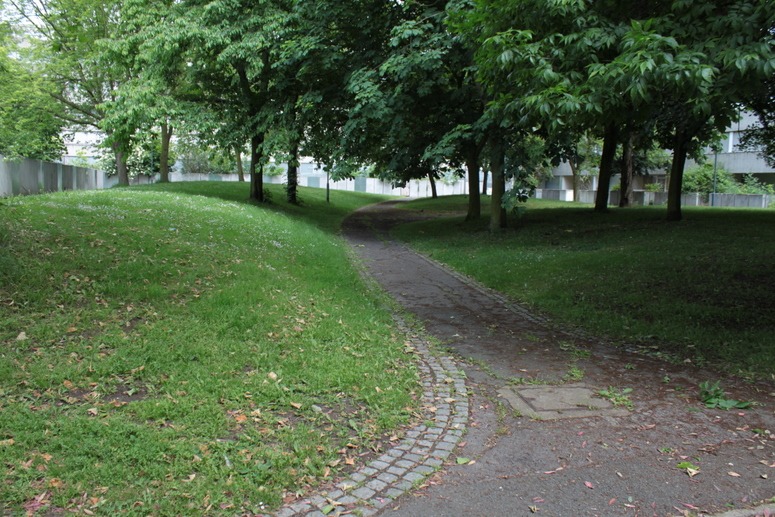Author Archives: Tom Turner
Eye windows make garden walls more friendly
London's Peace Garden and Democracy Village in Parliament Square UK
OK, it’s a mess.
But what should a ‘Parliament Square’ be used for? Parliament-related activities, obviously.
London’s Parliament Square is a traffic island. When not being used for protests, it is empty.
So why not designate Parliament Square as an area for political activity. The activity should be orderly, as in the Houses of Parliament, but there should be free speech, as in the Houses of Parliament. And there should be an Outdoor Speaker to give varied political groups chances to express their views.
We have had years of talk about pedestrianizing Parliament Square – and I favour the idea. But I don’t want the Square to become a sales venue for international coffee chains. Relating the use of outdoor space to the use of adjacent indoor space is often a good principle and this is a wonderful place to put it to the test.
The above photograph, taken today, is of the Peace Garden and Democracy Village in Parliament Square. The protest began on 1st May and the Mayor of London won a court injunction to get it removed last week. An appeal is expected and then the tents are likely to be removed. The handsome statue brooding over the scene is of Benjamin Disraeli. He is famous for his wit, for extending the franchise and for making Queen Victoria the Empress of India. What would he think of the current Afghan War and the protest? I guess he would be against the war, on pragramatic grounds, and against the protest, because it is a mess. But if it could be an orderly Garden Protest, I think he would regard it as an enrichment of our democracy, as would I.
The below photograph, also taken today, shows that London’s police force is a much more liberal institution than it used to be. Multi-everything is the new political correctness.
The Renaissance Garden in England by Sir Roy Strong – book review
I have been slow to review this book – the hardback (left) was published in 1979. The paperback (right) was published in 1998 with a statement from the author that ‘I intend to rework the whole subject, incorporating all that has happened in the last twenty years’. So my comments may be of use to the author.
(1) Put dates on the front cover
The present title may be compared to a book on The Great War in which you have to read half the first chapter to discover that it is really a book on The Great War 1914-16. Strong writes on page 13: ‘In this book I am only going to take one period and one thread. The period stretches from the accession of Henry VIII (1509) to the outbreak of the Civil War in 1642 and the thread is the evolution, design and meaning of the palace and the great garden’.
(2) Revise the book to include the century from until 1642-1742 (or more)
This is when Renaissance ideas had most influence on English gardens – as shown by Kip and Knyff’s topographic drawings. One could be disappointed in a book on The Second World War which only covered the period from September 1939 to the fall of France on 22 June 1940. As Kip and Knyff show in Britannia Illustrata, English gardens in 1707 were much more ‘Renaissance’ than ‘Baroque’. They had aignificant ‘Baroque’ aspect but it was never dominant. The avenues in the Kip and Kynff drawings half-hearted additions to fundamentally High Renaissance plans.
(3) Prefer the cover of the paperback edition, despite its parenticidal cropping (see the original)
As Roy Strong notes, on page 211, the garden of Packwood House (as used on the cover of the 1979 hardback edition) is ‘long famous as a garden planted in the 1660s, it was in fact, a mid-Victorian re-creation’. Apart from the question of it being a highly dubious ‘re-creation’, even the original is outside Roy Strong’s period
(4) Remove the book’s silly dedication
It reads ‘IN MEMORY OF ALL THOSE GARDENS DESTROYED BY CAPABILITY BROWN AND HIS SUCCESSORS’. The most significant Renaissance gardens discussed by Roy Strong are Hampton Court, Whitehall, Nonsuch, Kenilworth, Theobalds, Wollaton, Wimbledon, Richmond. Hatfield, Ham House, Worcester Lodge, Dowsby, Northampton House, Twickenham, Chastleton House, Gorehambury, Moor Park Herts, Wilton, Arundel House, Danvers House. A little historical investigation, aided by a pocket calculator, could reveal that >10% of these gardens fell victim to the landscape movement.
Small harbours can become great cities. Great cities can be desertifed
Once upon a time there was a small harbour on the edge of a great desert. The people lived happily, worshiped Allah, caught fish and raided passing mariners. British galleons came to stop the piracy. Later, the infidels discovered oil and water lurking far beneath the desert sands – and pumped them up. The small harbour grew to be a great city. Allah made the people rich, but he disliked the western ways.
Then an oil well blew out in the Gulf of Mexico. It too was run by the British and it made the seas filthy. Everybody hated this. So the Americans, the Chinese the Europeans and the Australians (who foresaw a comparable fate) hurled resources into energy research. In the first decade of the 21st century the Americans had spent more money on pet food than on energy research. In the second decade, the money spent on energy research towered over that spent by Russia and America on Atom Bombs, Ballistic Missiles and Moon Landings. Europe decided that the Romans and been geographically correct, so they invited North Africa to join the EU and then carpeted half the Sahara Desert with solar cells. Solar energy became so cheap that 75% of the world’s oil wells were shut down.
The great city on the Arabian Gulf spent its last tourism and oil revenues on solar-powered desalination, but global warming had made the region so hot that no one wanted to be there, even in winter, and the fossil water resources were all gone. So the great city which had been a small port, called Dubai, was abandonned like the Roman towns in North Africa.
The last woman to leave was heard to say: ‘Sheik Yamani, peace be upon him, was right “The Stone Age did not come to an end because we had a lack of stones, and the oil age did not come to an end because we had a lack of oil”‘
The last man to leave turned out the lights and muttered: ‘Allah be praised, Allah be delighted, blessed be the name of Allah to all Eternity’.
Policy implications of desertification
So the question is: what should be done to prepare for desertification? My belief is that instead of beeing looted as it is vacated, which is the usual fate of abandonned cities, Dubai should be carefully buried in sand for the benefit of future archaeologists. As at Pompeii, everything should be left, including furnishings, computers, books, booze, gold taps and porno videos (if present). The strongest argument for this approach is safety. A near-empty city could be more dangerous than Afghanistan. To make the deserted desert city safe, I imagine the best policy would be to explode a perimeter ring of buildings and add in other debris (eg cars) to make a barrier which would cause blown sand to accumulate. Wind tunnel tests should be put in hand to see if there are any urban design and planning measures which could assist the accumulation. Previous work on coastal sand dune stabilization would be useful.
Image note: the left part of the image is from a NASA photograph of Dubai; the right part of the image is of Devonian sandstone laid down under desert conditions near the Equator and then moved to Scotland by continental drift. The ‘lumps’ are breccia which became incorporated in the sandstone at the lower horizon of the sedimenary deposition. In geological time, everything changes.
Another modernist housing estate in London bites the dust – the Ferrier Estate
 After years of deliberation, they have begun pulling down the Ferrier Estate in Kidbrooke (London Borough of Greenwich). The estate looks decent, many of the external spaces are good and many of the residents were very happy living there. SO WHAT WENT WRONG?
After years of deliberation, they have begun pulling down the Ferrier Estate in Kidbrooke (London Borough of Greenwich). The estate looks decent, many of the external spaces are good and many of the residents were very happy living there. SO WHAT WENT WRONG?
See what the Ferrier Residents Action Group thinks. The London Evening Standard summarizes the situation as follows: “The Ferrier Estate is seen as one of London’s worst examples of Seventies planning, and its concrete towers were allowed to run down over three decades. Unemployment among its residents has been as high as 75 per cent. The estate was also plagued by crime and violence.” But unemployment, crime and violence (and drug-dealing) are not design problems and, as the Evening Standard‘s illustration shows, the morphology of the new housing is uncannily similar to the housing one can see being demolished (on the left side of the photograph).
I remember working on a number of projects like the Ferrier Estate during the 1970s and on one occasion the project team wanted to reduce the external works budget. I told them that ‘The oak trees on my drawings will be approaching maturity when they come to demolish your trashy little boxes’. On the evidence of the Ferrier Estate I might have added that ‘if you give me some money to spend on garden walls it might evey prolong their life’ (let’s hope they keep the good courtyards on the Ferrier Estate). If more musical, I should then have sung Pete Seeger’s Little Boxes:
Little boxes on the hillside
Little boxes made of ticky tacky
Little boxes
Little boxes
Little boxes all the same
There’s a green one and a pink one
And a blue one and a yellow one
And they’re all made out of ticky tacky
And they all look just the same Listen to Pete Seeger
The nicely treed courtyard in the photograph should have been (1) overlooked from the surrounding flats, as a traditional London Square would be (2) accessible to residents only (like the London squares around Ladbroke Grove). As presently managed, it should not be called a ‘yard’ or ‘garden’ – it is merely a public open space (POS) with no evident use. Bad management by Greenwich Council should not be used as an excuse for destroying the space.







